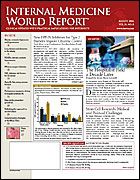The Metabolic Syndrome Adversely Affects Patients with PAD
New Evidence for the Importance of this Clinical Category
Journal of Vascular Surgery
Last year, the American Diabetes Association and the European Association for the Study of Diabetes called for a reexamination of diagnostic criteria for the metabolic syndrome and went on to question whether it even qualifies as a syndrome. New data published in the (2006; 43:1191-1197) provide strong support for the role of this clinical category.
This study, which included 334 patients with peripheral arterial disease (PAD) and intermittent claudication, found that the 133 patients who also had the metabolic syndrome had poorer physical functioning, reduced quality of life, and diminished peripheral circulation than those without the syndrome.
Patients were considered to have the metabolic syndrome if they met ≥3 of the following criteria: abdominal obesity, hypertriglyceridemia, low high-density lipoprotein cholesterol, high blood pressure (>130/85 mm Hg), or fasting glucose of >110 mg/dL. Patients with and without the syndrome were similar in terms of age, gender, race, history of intermittent claudication, ankle brachial index, and smoking status.
“The percentage of people in this study who had metabolic syndrome [39.8%] was higher than the 23.7% prevalence in the adult population but similar to the prevalence in those 60 years and older,” said lead investigator Andrew Gardner, PhD, of the University of Oklahoma Health Sciences Center, Oklahoma City. “They were assessed on metabolic syndrome characteristics and PAD-specific measures.”
P
P
P
P
P
P
P
P
Patients with the metabolic syndrome had a higher body weight ( <.001) and body mass index ( <.001) and were more likely to be obese ( <.001) compared with patients without the metabolic syndrome. Those with the metabolic syndrome also had a shorter initial claudication distance ( = .018) and absolute claudication distance ( = .025), lower peak oxygen uptake ( = .037), impaired walking economy ( = .021), and higher fractional utilization while walking ( = .019).
“Patients with intermittent claudication already have ambulatory dysfunction, are at the low end of the physical activity spectrum, and are limited in their daily physical activities,” Dr Gardner explained. “Compared with intermittent claudication patients without metabolic syndrome, our study found that patients with metabolic syndrome had even shorter walking distances to onset and maximal claudication pain during a treadmill test, lower cardiovascular fitness, shorter 6-minute walking distance, lower circulation in the legs, and lower quality of life pertaining to both physical and mental health.”
The study also showed that patients with the metabolic syndrome experienced claudication pain more quickly during the less-intensive, 6-minute walk test and felt they were less able to walk at varying distances and speeds and climb stairs.
“Metabolic syndrome puts patients who already are limited by intermittent claudication at greater risk for living a functionally dependent lifestyle,” said Dr Gardner. “We believe that aggressive risk factor modification for treatment components of metabolic syndrome should be evaluated for efficacy in modifying physical and vascular function in patients with intermittent claudication.”
Dr Gardner noted that it is equally plausible that patients with the metabolic syndrome can develop PAD and intermittent claudication, as well as have an elevated risk of subsequent cardiovascular morbidity and mortality. Further trials are needed to extend these preliminary findings, he added.
